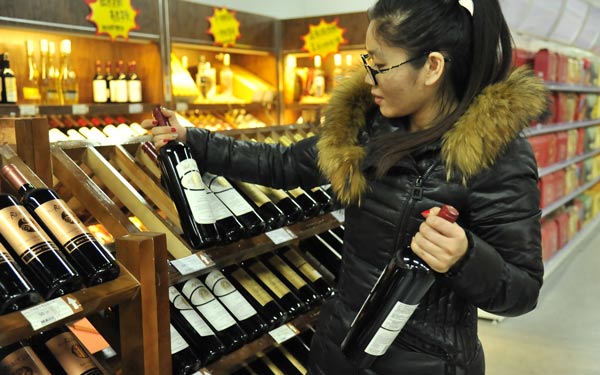 |
|
A customer considers imported bottled wine at a market in Qingdao, Shandong province. [Photo provided to China Daily] |
Red wine consumption in China dropped 5 percent in 2015, marking the second consecutive year of decline since 2013 when the country was ranked as the world's largest consumer, said Guillaume Deglise, the CEO of Vinexpo, the world's largest wine and spirits exhibition.
However, Deglise believes that wine in general will continue to be the major growth engine that drives the otherwise sluggish industry. China is currently the fifth-largest wine market and biggest spirits market in the world.
"There is unlikely to be more double digit growth in the Chinese market. But with its growing maturity, the outlook is still bright," said Deglise at a recent news conference in Shanghai.
According to a joint report released by Vinexpo and The International Wine and Spirits Research, red wine consumption in China enjoyed a whopping 74 percent growth rate from 2009 to 2013 in terms of volume. Together with the United States, Russia and Canada, China is among the four biggest red wine consuming countries. The US has retained its position as the world's largest wine market, and the report forecasts its growth rate to be 2.1 percent till 2019.
Though red wine-the color of which has been associated with luck and fortune in China-has dominated the market here, a similar fall has been seen in the general market that includes white and sparkling wines. Growth rate for wines is expected to fall from the 21.4 percent registered in 2010-14 to 3.8 percent between 2014 and 2019.
Deglise attributed the decline of the Chinese wine market to a variety of factors: the slowing down of China's overall economic growth, the Shanghai stock exchange collapse in August 2015, and the central government's efforts to crack down on corruption.
In contrast, the prospects for imported wine are looking bright in China. This particular segment experienced a modest 3.3 percent growth rate despite the decline of the overall wine market between 2013 and 2014. Deglise noted that this growth is likely to continue as high-quality and low-cost imported wines have already established themselves against locally produced wines, which accounted for 80 percent of the wine consumed in China in 2014.
French wine, Bordeaux in particular, remains the most popular imported wine, while Spanish wine is the fastest-growing import with a 277.2 percent growth rate. The US is the sixth-largest supplier of imported wine to China.
Though the per capita consumption of wine is still very low, Deglise noted that a growing number of people from China's expanding middle class have been switching from traditionally popular spirits like baijiu to wine. He added that the market will see millions more drinkers over the next few years.
This year's Vinexpo will take place from May 24 to 26 at the Hong Kong Convention and Exhibition Center. An estimated 1,300 international exhibitors from 34 countries and 16,700 visitors are expected to participate in the event.
